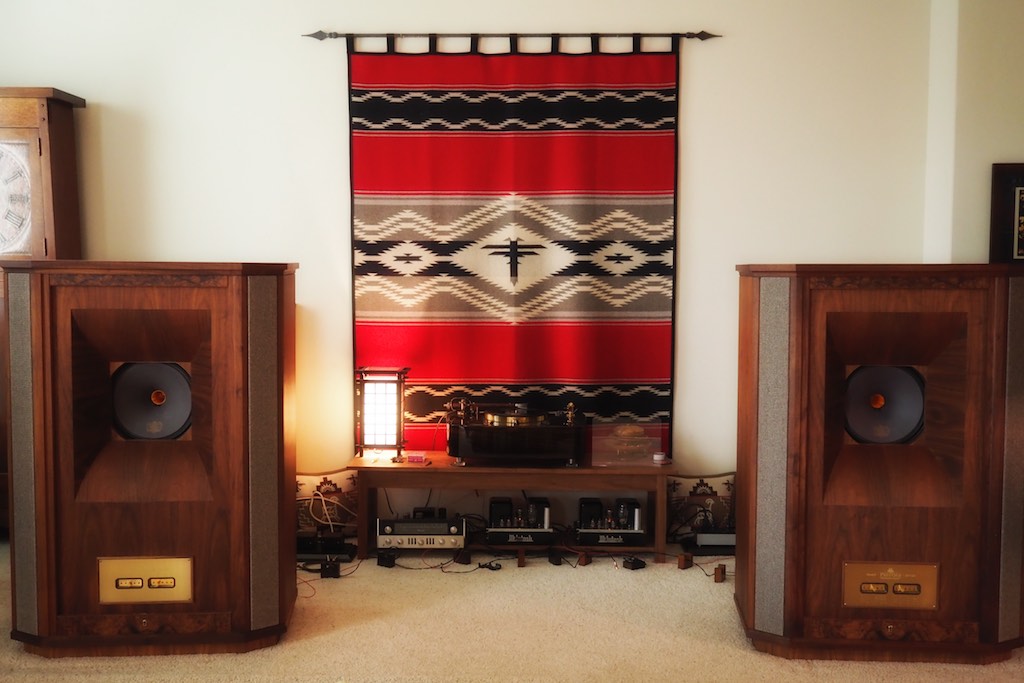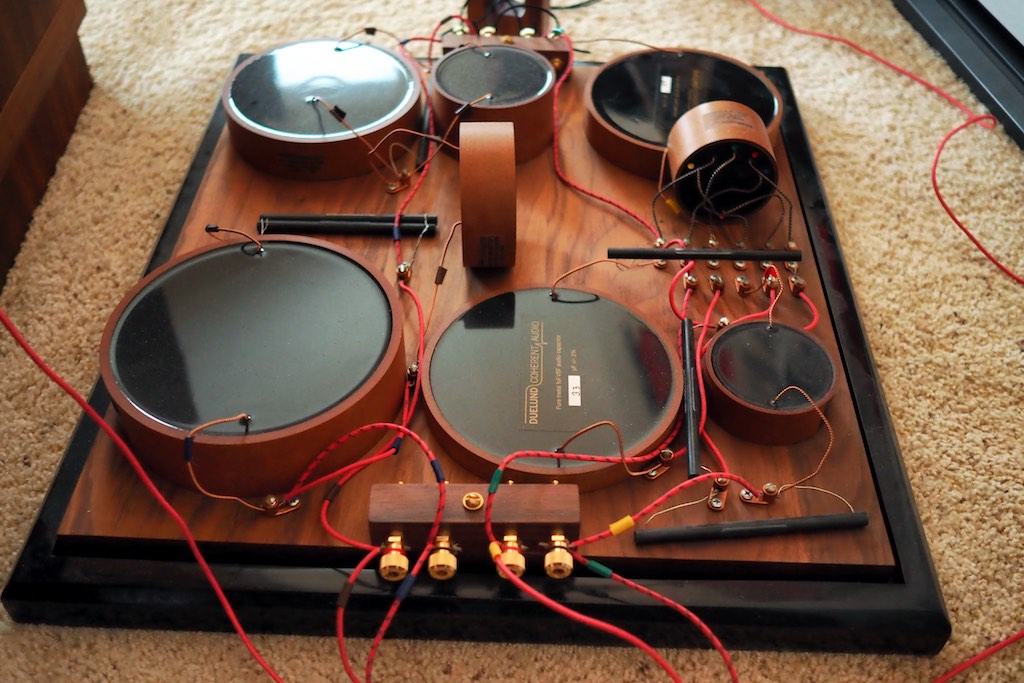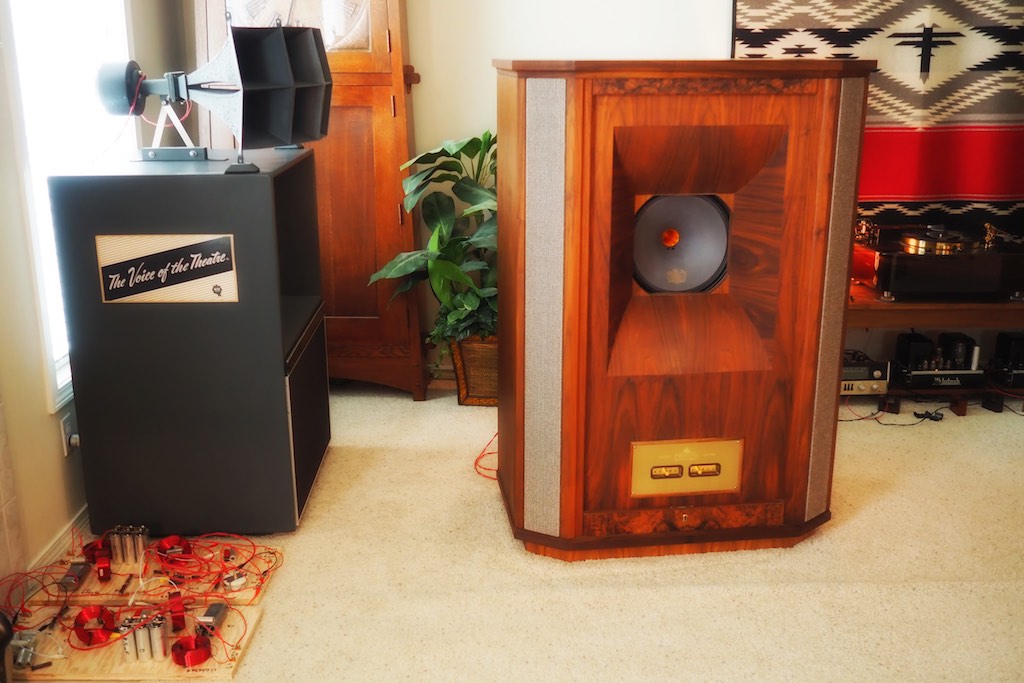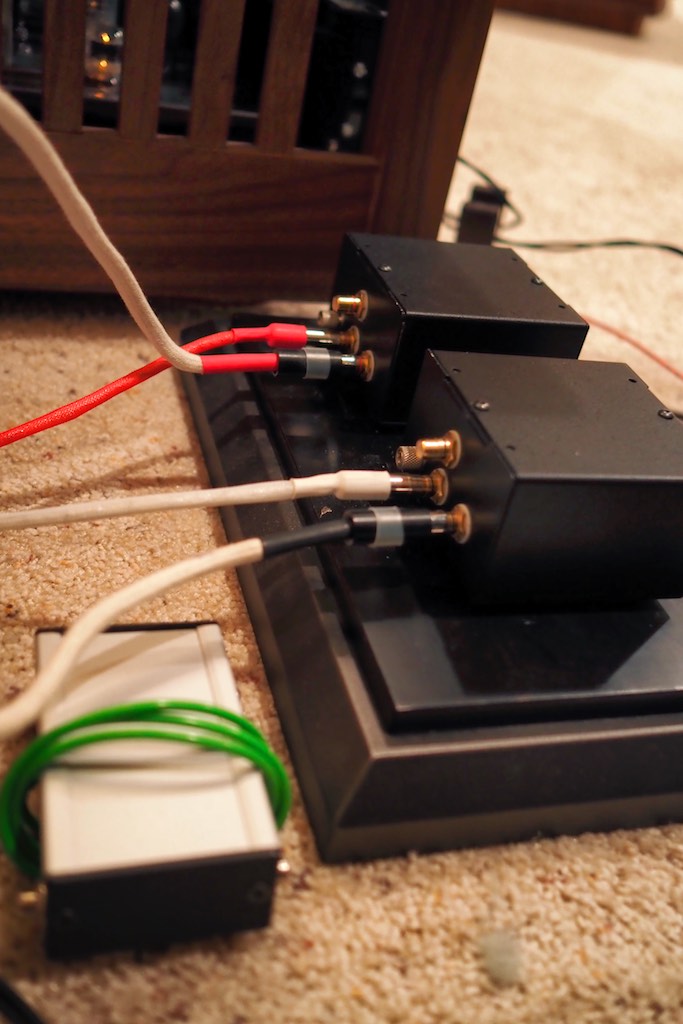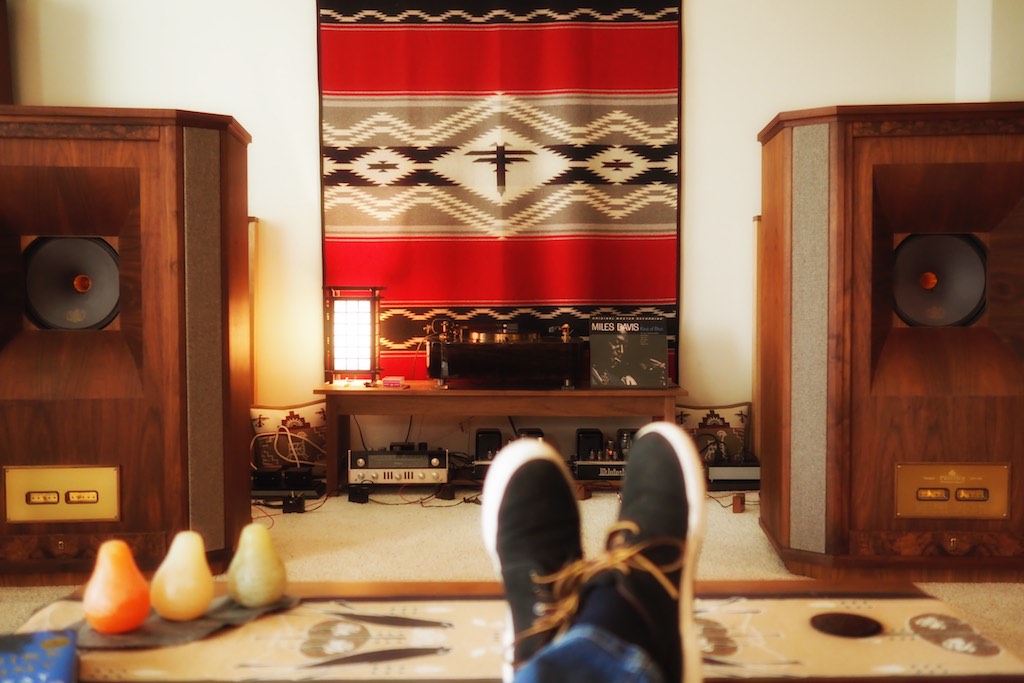The last week or two I had begun to miss my usual Tannoy Westminster Royale SE loudspeakers with their Duelund CAST crossovers, so I pulled my vintage Altec A5 Voice of the Theatre project loudspeakers out of the system, and put the big West's back in.
Please don't take that as condemnation of the vintage Altec A5's, as it merely means that while the A5's are out of the system their crossovers will transition from breadboards to final design, which is in itself quite exciting!
I plan on reducing the A5's crossovers' bases in size, with the idea of mounting them inside the 825B bass horns, or possibly sitting them on top of the bass horns, so the A5's have a more compact footprint, and a better chance of fitting into the available space in their eventual new home, my TV room.
I'll have quite a lot more to say about the A5's as they enter into this exciting final stage of crossover development.
It was quite a workout moving those big & heavy loudspeakers around and putting them into position by myself! Whew!
After I got the big West's into position I fired them up to give them a listen, with first honors going to the Analogue Productions 45RPM version of Ella Fitzgerald's Let No Man Write My Epitaph.
Trouble in paradise. The Duelund DCA16GA interconnects that are such a brilliant match with my more laid back vintage Altec A5 Voice of the Theater loudspeakers, were too vivid & forward in the high-frequencies of the Westminsters (as were the vintage Western Electric WE16GA as interconnects before them). The WRSE's are a bit fussy in that regard
When you get the Westminster's tonal balance right they are astonishingly good loudspeakers, when you don't, you suffer, as their metal high-frequency horns will take your head off if you get them wrong.
So out came the Duelund DCA16GA interconnects, and in went the more laid-back Duelund silver foil & oil-baked silk interconnects that Chris at Parts ConneXion made for me to try (Chris will make bespoke Duelund interconnects for you if you tell him Jeff sent you, and ask nicely).

Duelund soft annealed silver foil interconnect with oil-soaked & baked silk dielectric, on my vintage McIntosh MC30 monaural amplifiers.
The Duelund soft annealed silver foil interconnect with their oil-soaked & baked silk dielectric are a beautiful match to the Westminsters' high-frequency drivers, with a smooth, rich, detailed, and natural presentation.
If your high-frequencies are too forward or harsh, these Duelund soft annealed silver foil interconnects could be your answer for taming them, just as they did with my Westminster's. (Paul, you might want to consider giving these a try for your Horning Euphrodite Lowther drivers.)
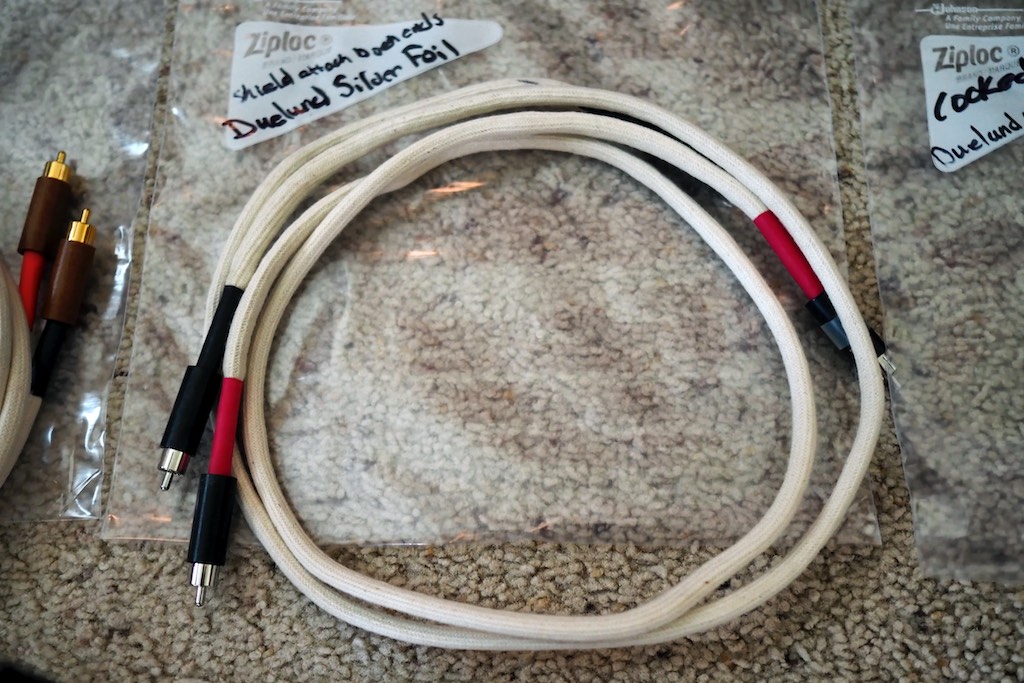
Duelund Shielded Soft Annealed Silver Foil Interconnect constructed Yazaki-san style with shield grounded at both ends.
That success got me to thinking that the set of shielded Duelund soft annealed silver foil interconnects that Chris made for me would be a good choice for use with my Intact Audio bespoke monaural SUTs that I use for my Ortofon SPU Classic GM MkII phone cartridge, so I put them into the system to give them a listen.
Trouble in paradise part 2. The set of shielded Duelund soft annealed silver foil interconnects that Chris made for me sounded a lot like the Duelund DCA16GA interconnects, being astonishingly transparent, but too vivid & forward in the high-frequencies of the Westminster's.
The set of shielded Duelund soft annealed silver foil interconnects that Chris made for me had their tinned-copper shield connected to ground at both ends, Yazaki-san style, which essentially puts the shield in the circuit as a conductor. I figured that was what was responsible for what I was hearing from them, so I decided a shield-ectomy was in order.
I unscrewed the handles on the Duelund Rhodium RCA's, and pulled back the cotton wrap of the interconnects to expose the shield, pulled the shield free of the RCA's, and then trimmed away about a 1/4-inch of shield to make sure it severed the ground connection.
After reassembling the Duelund soft annealed silver foil interconnects, now with their shield connected only at the source end, I put them back into the system to give them a listen.
Now they sounded a lot more like what I was hearing from the unshielded Duelund soft annealed silver foil interconnects, whose smoother, more laid-back tonality is a much better match to the metal high-frequency horns of the Westminster's.

Unshielded ends of the Duelund soft annealed silver foil IC's connected to the MX110Z's phono inputs.
On the Mo-Fi 45RPM version of Miles Davis' Kind of Blue the modified shielded Duelund soft annealed silver foil interconnects were a much nicer match now, giving much improved tonality.
If you're going to make up some shielded Duelund soft annealed silver foil interconnects, you definitely don't want the tinned-copper shielding in the signal path, or you won't be able to hear the beautiful tonality the soft annealed silver foil in their oil soaked & baked silk dielectrics are capable of. For this specific application I recommend that you connect the shield only at the source end.
In a conversation with Pete Riggle when I was interviewing him about his tonearm, he mentioned to me that I should try what he does for his tonearm cables, which is to not connect the shield to the RCA's ground at either end of the interconnects, but instead to connect the shield to a grounding wire at the source end, and then connect the ground wire to the source end component ground. Pete say's it makes for a much better sounding shielded cable, so I'll have to give that a try and report back.
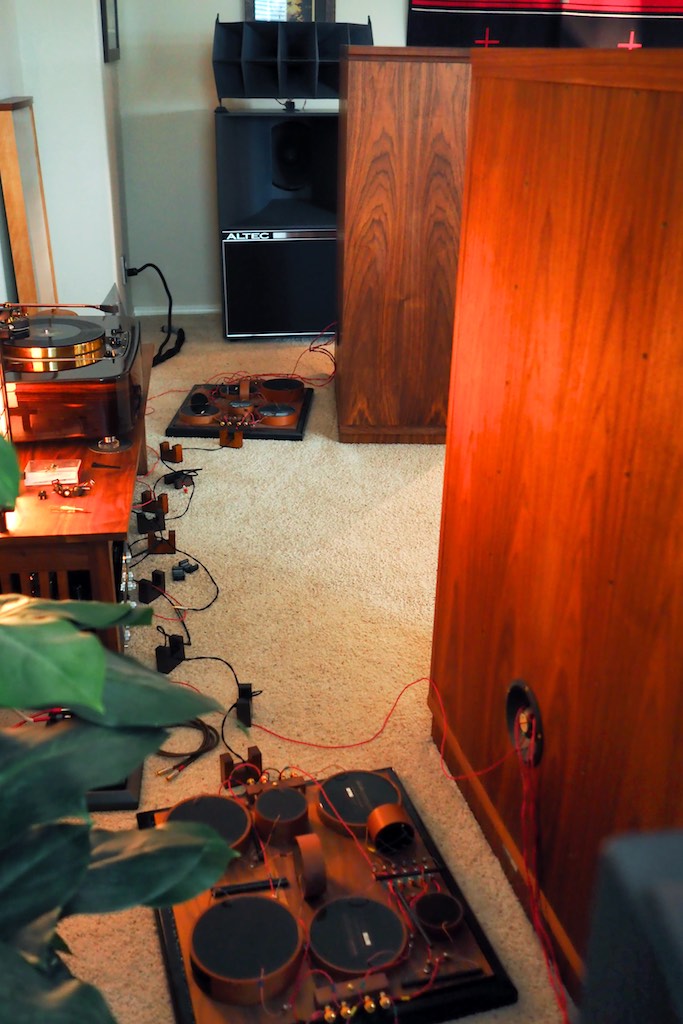
The behind the speaker view. The WRSE's are wired internally with Western Electric WE16GA, as are their Duelund CAST crossovers. The speaker cables are Duelund DCA16GA.
The Duelund soft annealed silver foil wire with its oil-soaked silk dielectric, is transparent & articulate, but with a smooth, rich, and laid-back balance, that doesn't sound like any silver wire I've ever come across (i.e. it's way good), and it has a tonal balance that really complements the high-frequency tonality of my Tannoy Westminster Royal loudspeakers.
As I get more time on the Duelund soft annealed silver foil interconnects I'll report back with more detailed impressions, and I'm thinking I need to give Pete's 'floating shield' and ground wire approach a try as well, so more to come.
As always, thanks for stopping by, and may the tone be with you!
Update: I forgot to mention that Chris at Parts ConneXion used the Duelund 1.0 silver foil in silk/oil to build the interconnects. It's quite expensive at $15.98 per foot ($192 just for the wire for a pair of 1-meter interconnects).
Chris also told me that due to all the orders he's been getting from you, that he sold out of the Duelund RCA's for the next 2 months, until his next shipment arrives. Chris says he likes the KLEI and DH LABS direct gold over copper RCA’s as very good substitutes.
I haven't yet been able to compare the Duelund RCA's performance to the venerable (and cheap) Switchcraft 3502AAU (gold plug & nickel handle) RCA’s that I am so fond of for duty with vintage gear.
It is readily apparent that the Duelund RCA's are made to a much higher level of quality than the Switchcraft RCA's, but I haven't been able to compare them directly yet to hear how they compare in sound quality.
So far I've liked the Switchcraft's better than anything else I've tried from a sonic and musical standpoint, with the bonus that they easily fit in tight vintage audio gear spacing (and modern tight TV spacing) when a lot of other RCA's don't.
As soon as I get the 1-meter pair of Duelund DCA16GA interconnects I built with Switchcraft RCA's back from Pete Riggle, I'll compare them to the DCA16GA interconnects Chris built with the Duelund RCA's and hear what happens.
Thanks for stopping by!




